Hello! I'm Shen Javier, former president of Effective Altruism UP Diliman (EA UPD) for AY 2020-2021. This post summarizes how we organized our first introductory fellowship which we named the Utak at Puso Fellowship and was held last February to May 2021. We hope that EA group organizers, especially those who will soon run a fellowship, will find this helpful.
Summary
EA UPD recently held its first introductory fellowship last February to May 2021 with students from different programs, year levels, and universities in the country. We think it was very successful, with us having 28 graduates out of the 36 accepted fellows and an average likelihood to recommend rating of 9.43/10. Five of our fellows also ended up joining our Executive Board.
- Recruitment
- The remote setup of learning and work allowed students from all over the Philippines to apply for the fellowship. Because of this, they had greater flexibility to participate in extracurriculars.
- Recruitment was also successful through the help of other student chapters in the Philippines and through Facebook ads where we spent ~20 USD that attracted 7 people who completed the fellowship.
- Our application included answering a form and an interview, and we accepted all those who finished these two phases.
- Structure
- Our fellowship lasted for 10 weeks, including the weekends of EA Reconnect and the Fellowship Weekend.
- We had two cohorts - one met every Saturday and one met every Tuesday. Groupings within these cohorts changed every week for fellows to meet more people.
- We held two socials and made a Discord server to communicate with the fellows.
- Key learnings
- Foster belongingness in the community.
- Reach out to fellows personally for opportunities that fit them and create space--both in online chats and social meetups--for fun and engaging activities.
- We believe we were able to build genuine connections with our fellows and this has allowed us to support them in how they want to be involved in the EA community, particularly through advice, inspiration, and resources. In this way, we can further cultivate the mission to have these students engage in EA-aligned projects.
- Be innovative with the curriculum.
- Figure out what works best for the type of fellows you have or might have. Ask which topics or activities are most important for them to discuss or do. In our case, fellows seemed to need more guidance and time for career planning.
- End the fellowship on a high note! Make this a time for fellows to shine and showcase what they were able to get from the fellowship. Fellowships in the Philippines usually end with the fellows giving lightning talks. We believe capstone projects like infographics, e-zines and animated videos would be interesting to see in future runs to provide them alternative options in presentation.
- Work on accessibility.
- While most of the country is still under a remote setup of learning, not everyone has good access to the internet. This could prevent promising students from joining our fellowship. We are considering giving internet subsidies next time to make the fellowship more accessible.
- A lot of our fellows and our potential reach also feel more comfortable speaking in our national language. This should be kept in mind when creating materials and cultivating the environment during sessions.
- Facilitators are also learning.
- While most of our facilitators were professionals and have facilitated before, we also had a few first-timers like myself, and we see more first-timers being our facilitators for the next runs. Given this, we have to be more mindful about helping each other be better at facilitating such as ensuring a feedback updating system and creating collaborative resources notes for facilitators.
- Foster belongingness in the community.
Acknowledgements
EA UPD would like to thank EA Philippines for their help in organizing this fellowship, from crafting the syllabus to facilitating sessions. We would also like to thank the other Philippine student chapters, EA Blue and EA DLSU, for sharing resources and helping us widen our reach. This fellowship would not have happened without your support.
Background on EA UPD
EA UPD is the second EA student chapter in the Philippines. It is based in the University of the Philippines Diliman (also known as UPD or UP Diliman), which is the top university in the country. With the help of EA Philippines, our chapter started last November 2020 and has just been recognized as an official organization of the university this second term of the academic year.
Our initial team and the core team for this fellowship was made up of four Executive Board members and two volunteers from UP Cebu.
Why was it called Utak at Puso?
Utak at Puso is a phrase commonly used by people from the University of the Philippines to remind themselves to point their excellence towards serving others. It is Filipino for “brain and heart” or “head and heart,” the latter being a common phrase to describe EA as well—combining both the head and the heart to help others.
We named the fellowship Utak at Puso to hopefully make it easier for UPD students to resonate with the values of EA and we think that the fellowship was easier to promote because of this familiar phrase.
Goals
Our fellowship aimed to fulfill the following goals:
- Introduce the university and similar communities to EA.
- Grow the organization since this fellowship also served as the application process to being a member of EA UPD.
The rationale for the second is that students who have committed to finishing the fellowship will be more knowledgeable about EA and more likely to be dedicated to the organization and to EA. This process is also in line with the organization culture in the university, which usually requires undergoing months or semester long activities before officially being a member of the organization. We considered this to make EA UPD more familiar to our co-students.
Recruitment
Our main activities for recruitment are a) an online EA concepts campaign, b) an Introduction Talk to EA, and c) using Facebook ads. We think our recruitment went well with us getting 36 fellows to start the fellowship, way higher than our target of 20. We think that the shift to virtual classes also allowed us to have a wider reach since students from other places in the country can join with their schedule also being more flexible than the ones they have face-to-face.
Online campaign
Our online campaign consists of a series of posts about EA cause areas. For a certain cause area, we answer why it is important, how EA works for this cause area and what they can do to help. You can view them on our Facebook page.
We wanted our page to have the basic information people need to know about EA and aimed to widen our reach by sharing these posts on our personal accounts and inviting people we know who could be interested in EA.
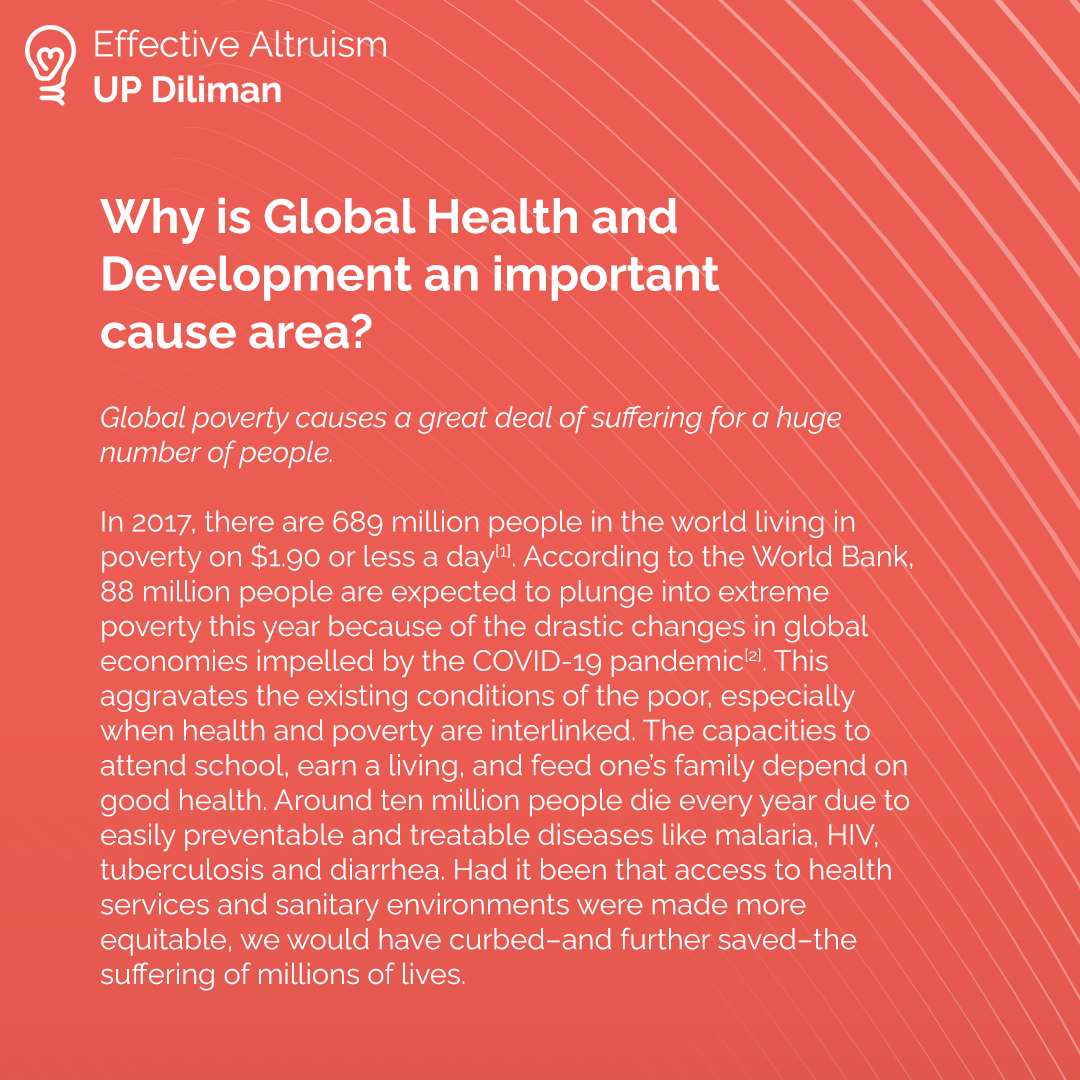
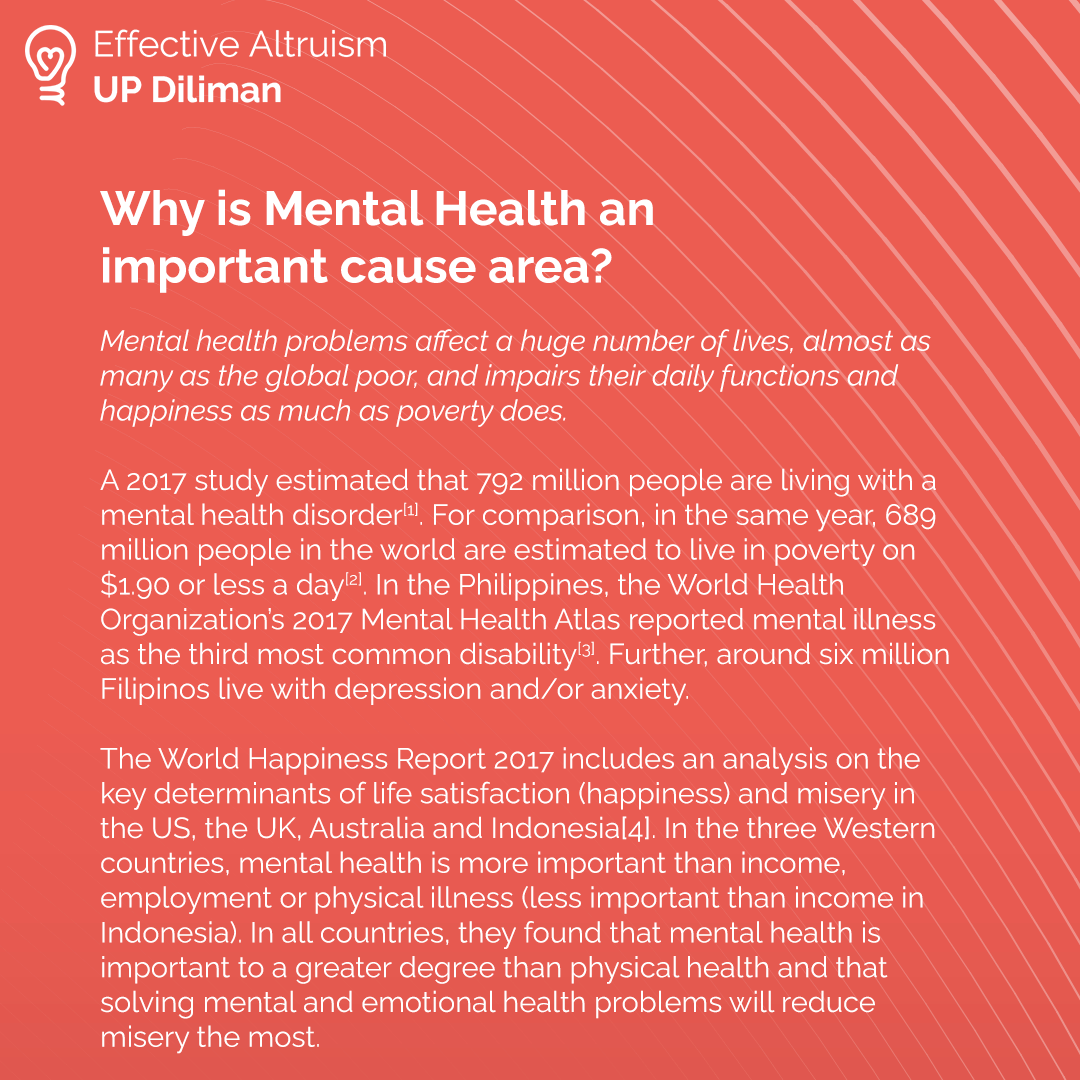
Introduction Talk to EA
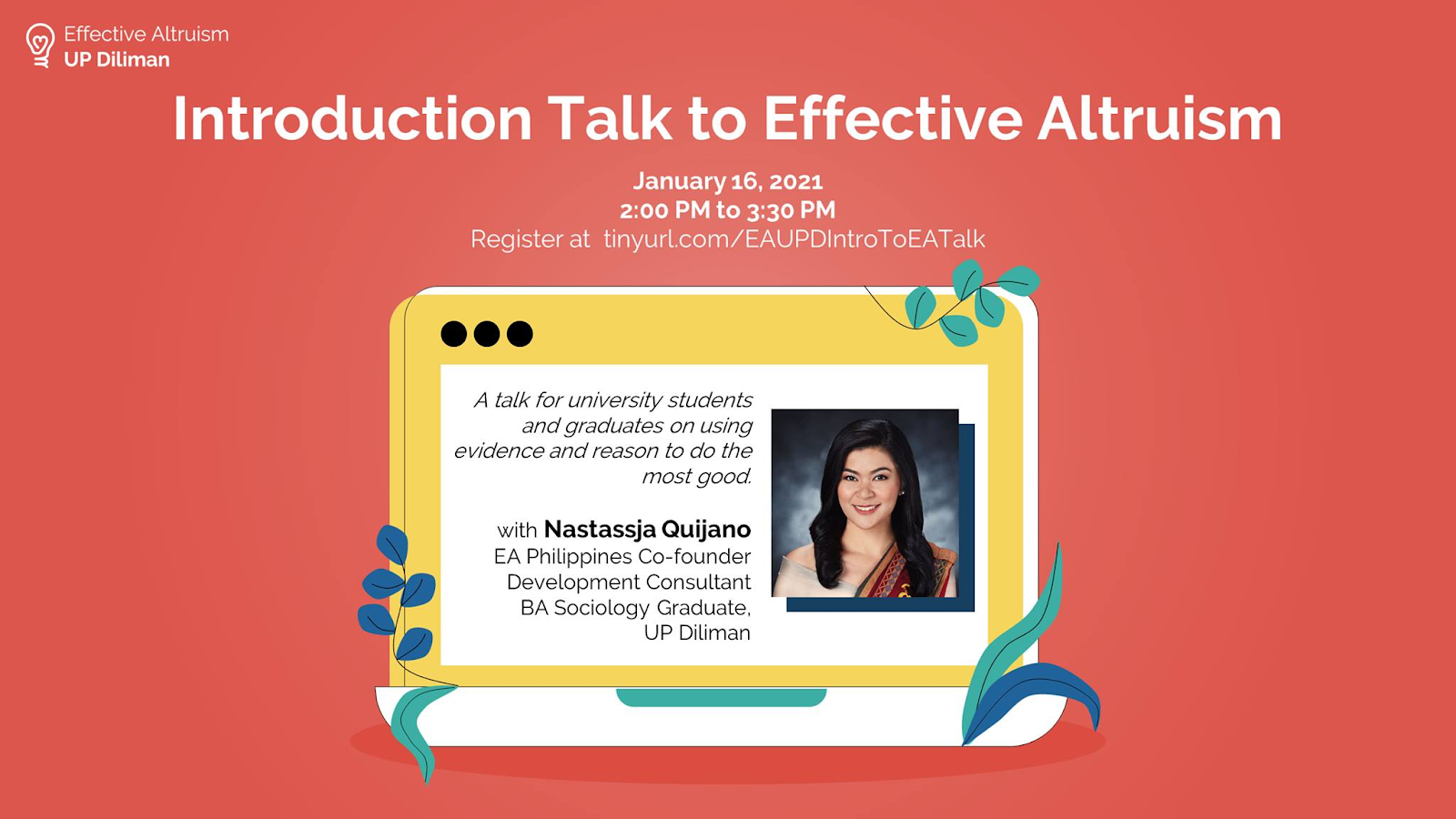
We then held our first event last January 16, 2021 which is an introduction to Effective Altruism. We had Nastassja "Tanya" Quijano, an alumna of our campus and co-founder of EA Philippines, as our speaker. Aside from Tanya’s experience in development work, since she is also from our university, we thought that students in our university would find her more relatable which could influence them to join the event and the organization.
Our program lasted for about an hour and included breakout sessions to discuss more about the talk (see Appendix A).
We had 33 attendees from different universities including ours and the universities of the other EA student chapters in the Philippines. From these 33 attendees, 7 eventually joined and graduated from the fellowship, 3 became members of EA UPD, and 1 became an Executive Board member. We had an avg. likelihood to recommend rating of 8/10.
You can check our Mastersheet for this event here. This includes the questions that we prepared for the icebreaker and breakout sessions. You can watch a recording of the talk on our Facebook page.
Facebook ads
After the talk, we created more social media posts to promote the fellowship, including testimonials from UPD graduates like the photo below. We also attached a primer with the fellowship mechanics, testimonials and FAQs.
Our sign-ups were open for 3 weeks but halfway into it, we only had a handful of applicants so we decided to advertise the fellowship on Facebook. We spent Php 1000 or ~20 USD for this and ended up with 10 out of 42 signups hearing about the fellowship through the ads. Only 8 of them went on to start the fellowship but 7 graduated, so we think that using these ads was still successful.
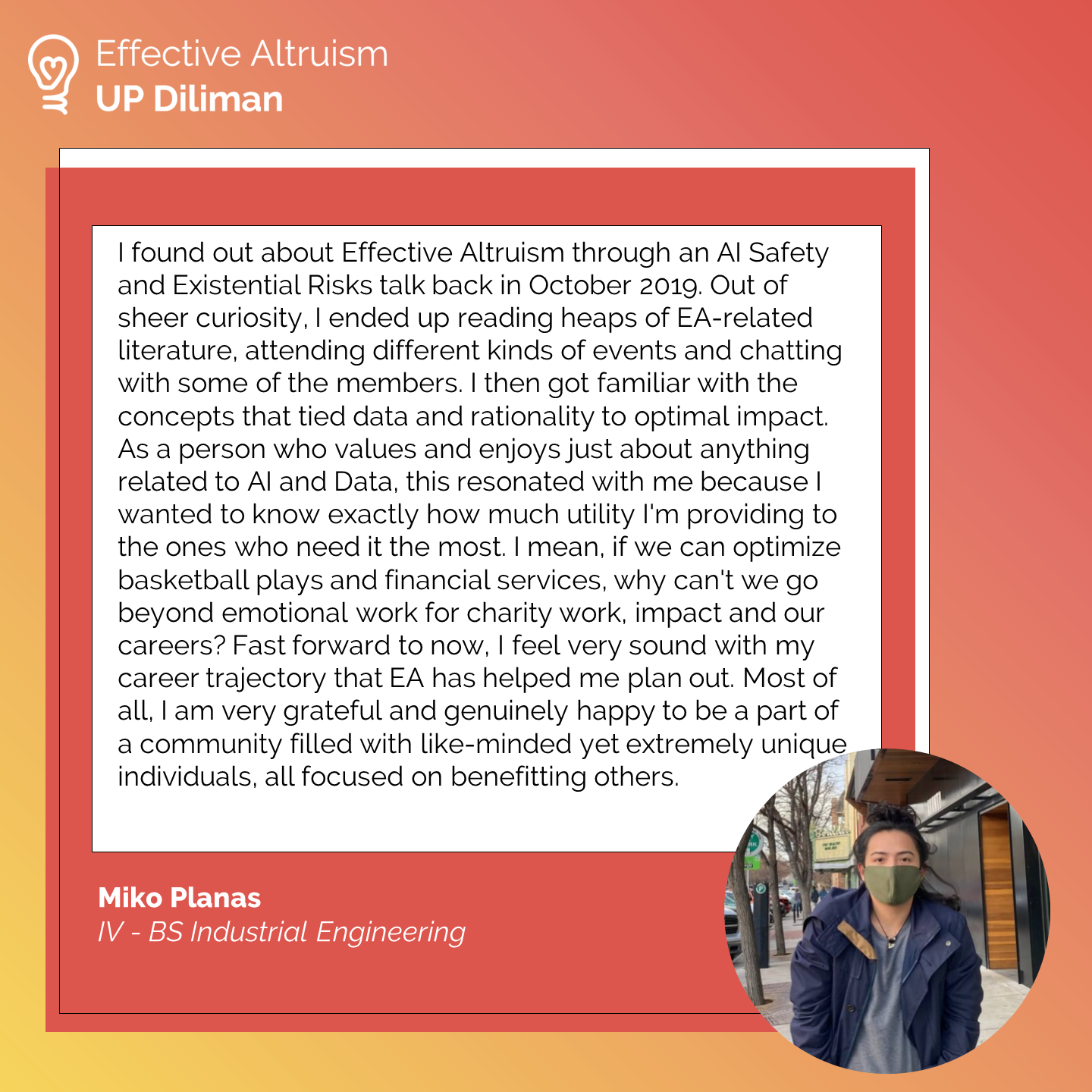
Application process
We had people fill up this form and schedule an interview with us so we could have a better sense of how they would be performing during the fellowship. We put value in their commitment, engagement in conversations and openness to hear others’ thoughts.
We ended up accepting everyone who has finished the interview and we did not plan to significantly reduce the number of potential fellows since we wanted to get as many people involved as possible. We think that this was a good way to set expectations for the fellowship, that it is serious and will really require effort. It was also a way for us to address any concerns they had about joining the fellowship.
Our Fellows
Our fellowship was open to students from other universities and from different year levels.
Most of our fellows were from UPD and then the next largest groups were from De La Salle University - Manila (DLSU-Manila) and Ateneo de Manila University (ADMU), both of which are home to the other EA student groups in the Philippines. We also had fellows from other campuses of our university (UP has 8 main campuses all over the country) and from universities in the other two main islands of the country. Most of the fellows were in their third year in college, but we also had 2 graduate students and 2 senior high school students.
Most of the fellows had only consumed 1-3 hours worth of EA content, but we had 3 who had read for more than 30 hours, most of which are EB members of EA DLSU-Manila.
In terms of courses, we had 6 main groups (arranged in descending order):
- Sciences e.g. Physics, Biology, Nursing
- Business Administration, Economics, Statistics
- Engineering e.g. Civil Engg, Chemical Engg
- Humanities e.g. Philosophy, Political Science
- Management/Industrial Engineering and Information Technology
- Arts and Architecture
We think these suggest a diverse set of fellows that we found valuable in discussions and community-building.
Their initial cause interests were:
- Health and poverty
- Environment, Climate Change
- Gender inclusivity, feminism, sexual harassment
- Education
- Strengthening institutions, improving decision-making
- Improving research
- Cause prioritization
- AI safety, emerging tech (biotech, nanotech)
- Farm animal welfare
Which also reflect some knowledge of EA concepts and more apparent problems in the country.
Structure
Our fellowship consists of 7 meetups and 3 external events across 10 weeks. To be considered a graduate of the fellowship, fellows needed to attend 6 out of the 10 weeks. This was held completely online due to the COVID-19 pandemic restrictions.
For our meetups, we had two cohorts - one met every Saturday and one met every Tuesday. We split the fellows and the facilitators into these two cohorts based on the availability they gave us in the application form. There were 17 fellows and 5 facilitators in the Saturday cohort and 19 fellows and 5 facilitators in the Tuesday one.
We had 9 facilitators overall with one having to facilitate in both cohorts. Four of them were current UP students and three of them graduated from UP. Six of them are professionals from EA Philippines who we needed to have since we did not yet have enough manpower and experience to facilitate the sessions on our own.
Syllabus
Our syllabus was adapted from EA Oxford’s EA Intro Fellowship curriculum with the help of Brian Tan from EA Philippines. This was our weekly schedule:
Week 1: The Effectiveness Mindset and Thinking More Rationally
Week 2: Introduction to EA Concepts Workshop
Week 4: Expanding Our Compassion
Week 5: EA Reconnect Virtual Conference
Week 6: Fellowship Weekend Networking Event
Week 7: Longtermism and Improving the Long-Term Future
Week 10: Effective Altruism in Action - Lightning Talks
We included three events in this fellowship: the Introduction to EA Concepts Workshop by EA Blue (ADMU), the EA Reconnect Virtual Conference, and the Fellowship Weekend Networking Event.
We added EA Blue’s workshop since the concepts for the first weeks in most fellowships will be discussed in the workshop already. Since most of the fellows did not qualify for EA Reconnect, this served more as an off-week for them. The Fellowship Weekend was the better fit global event for them and we supplemented this networking with a mixed socials for our fellows and EA Blue’s fellows.
During Week 4, we had a main set of required materials on who our moral consideration should expand to, a set on animal welfare and another on mental health. We asked fellows to read the main set and choose which of animal welfare and mental health they would want to focus on. For the meetup, we assigned them into groups that discussed their chosen topic. This was something that EA Blue did during their first intro fellowship and found successful so we replicated it to give the fellows more chance to discuss other cause areas.
For Week 9, we had fellows answer this Career Planning Worksheet and we grouped them together with facilitators who have relevant experience in the field they want to pursue. For Week 10, we asked fellows to prepare an 8-minute presentation on their chosen EA or EA-aligned organization. We opened the floor for questions after every presentation. These activities for Weeks 9-10 have been part of fellowships EA PH has held before.
Meetups
While we had people stay in the same cohort for the whole duration of the fellowship, we put them in different groups every week for discussions. We usually had 3-5 fellows for each facilitator in a discussion group. We grouped them according to schools or locations, hours spent learning EA, and cause area interests and career paths as Week 4 and Week 9 required.
Our weekly meetups lasted for 1.5 hours and the program flow is as follows:
- Intros (5 min)
- Waiting for fellows and check-ins
- Icebreaker (10 min)
- With the same grouping for the discussion
- View all the icebreakers we used in this doc.
- Discussion (60 min)
- We used this agenda doc to structure the discussions.
- This asked fellows to upvote which topics, questions or resources they want to talk about the most. We encouraged facilitators to use this system but adapt to whatever fit their group.
- Recap (10 min)
- We asked one representative from each group to give a recap of what they talked about.
After every meetup, facilitators stayed for around 15 minutes to debrief on the week’s session. We talked about how fellows performed that week, challenges and common themes during discussions and things to take note of for the next week.
Other initiatives
Communication
We made a Discord server (see Appendix B) where we invited fellows and facilitators to join. Aside from being our main channel of communication for the EB to organize the fellowship, we used this to send reminders and post announcements about the fellowship to the fellows.
We also had channels to promote EA-related opportunities and events to help the fellows stay involved in the EA community outside of the fellowship. There were channels to discuss and share content on cause areas and other interests and social channels for co-studying, EA memes and hobbies.
We sent out Google Calendar invites for meetups and socials and emails for important announcements. We also indicated which of the EB to contact for certain concerns e.g. a point person for attendance matters.
Socials
We held two socials during the fellowship - one during the week of EA Reconnect and one with EA Blue during the week of the Fellowship Weekend. We held the first social during EA Reconnect since the fellows did not join the conference and since we were already halfway through the fellowship. We held the second one so that our fellows and those of EA Blue would get a chance to meet each other already since they would probably be seeing and working with each other if they decide to be active in EA.
We had icebreakers that were mostly non-EA questions and games, such as Guess the Song, Bring Me, and Trivia Quiz.
Fellows and Facilitators Profiles
We asked fellows and facilitators to create a profile page in Google Slides using this format. This is so they would know who they could potentially connect with in the fellowship.
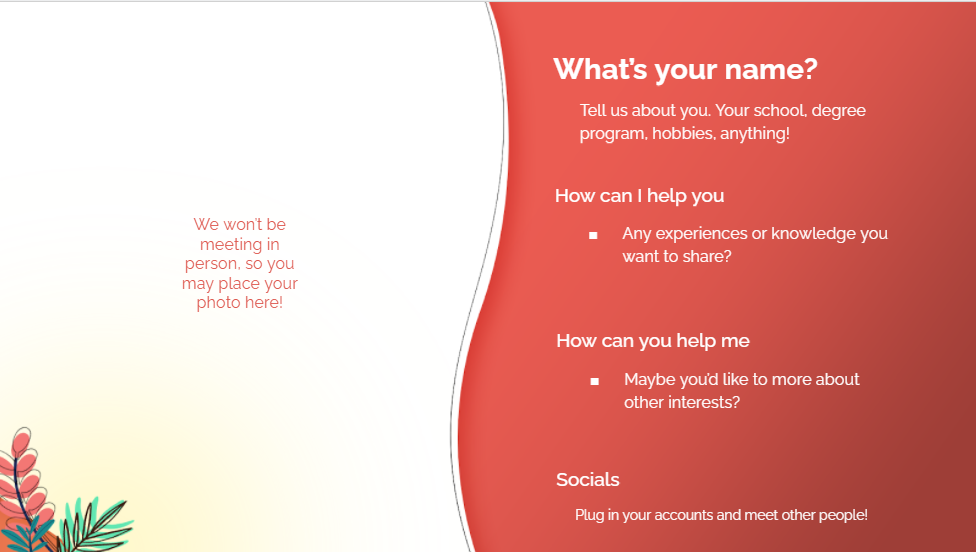
Evaluation
For our evaluation, we based it on the responses for our completion survey and from discussions with the core team and the facilitators.
Project Success Indicators
| Success Indicator | Result | Notes |
|---|---|---|
| Have at least 20 participants | Accomplished | 36 fellows officially started the fellowship |
| Have 70% of the applicants complete the fellowship (attend 6/10 meetups) | Accomplished | 78% or 28/36 of the fellows graduated |
| Have 3 fellows willing to be part of next year's EB | Accomplished | 5 fellows are now part of the current Executive Board |
| Have 5 fellows willing to be part of the core team | Not accomplished | Our new structure did not require us to fill in these 5 positions yet but we only have 4 more members left so we would not be able to reach this either way. |
| Have an average likelihood to recommend of 9/10 | Accomplished | Avg. rating was 9.43/10 |
Insights on fostering belongingness
Our completion survey showed an avg. rating of 8.95/10 for this question: Based on your experience in the fellowship, how much do you feel like you belong in the effective altruism community?. According to Marie Davidsen Buhl from CEA, this was the highest they have seen when we submitted our survey responses.
It could be that we were just really lucky to have a good batch of fellows so these insights are more about the conditions that allowed them to have this high feeling of community instead of things that we actively did, but I do think these conditions are replicable, which is why we are sharing them.
- We had good and relatable facilitators.
- Like I mentioned above, most of our facis are UP alumni or students, which gave the group something common to begin with.
- The facis completed an introductory fellowship before and they shared about their experiences as fellows too.
- People came from diverse backgrounds.
- Fellows came from different places, courses, and have different personalities, which made it very likely for someone to find at least one person to get along with.
- People felt comfortable using the language they wanted to use.
- The country’s official languages are Filipino and English and we used the latter for our materials, but fellows were encouraged to use whatever language they prefer, which led them to being able to express themselves better. This made the fellowship feel more inclusive since a lot of people still feel anxious about speaking in a non-native language.
- Fellows were open to discussions and were not aggressive.
- We did not get any reports about fellows being abrasive during discussions, which we think is something organizers can control during the application interview.
- They were the pioneer batch so they felt eager to contribute to the organization.
- This was our first run of the intro fellowship so everything was still new and exciting, and people found it easy to contribute to the org in one way or another, i.e. sending suggestions for next runs, running for the next EB.
- We think fostering this feeling of being valuable to the org helps in making fellows feel part of the community.
- Three of the fellows were also part of the Executive Board (EB).
- Most of the people in our EB have not been exposed to EA for a long time so they also participated in the fellowship. This made the EB seem more relatable and approachable to the fellows.
- We think this is not usually the case for most fellowships and will probably not be for our next runs too, but this highlights the importance of making the fellows see the core team members as just someone like them and not someone they have to report to.
The next sections will talk about things that went well, things that we could improve on, and other tips and suggestions for running an introductory fellowship. I only highlighted some points here, but you can see the rest in this evaluation summary which is arranged by aspect of organizing a fellowship.
What went well
Here are other things that went well:
- The application interview received good comments.
- Fellows found it casual but still asking for the right information.
- This could be shorter though and make sure that the questions match our criteria, particularly, potential and commitment.
- Communication of fellowship reminders was good.
- Most fellows found the Discord server useful and are extremely satisfied with our handling of announcements/reminders and our responsiveness.
- We had a good number of signups.
- Facebook ads were useful.
- Fellows are from different courses, places, school levels, etc.
- Socials were enjoyable!
- But we could have had more asynchronous socials in the Discord server.
- We had great facis.
- With an overall score of 4.75/5
- Having great facis did not just help in the actual discussions but also in promoting the fellowship. We think that students were more interested to join if they knew professionals or good students would be facilitating them.
What did not go well or areas for improvement
- The syllabus and schedule can be refined. Think about:
- weeks that could be combined together i.e. Existential Risks and Longtermism (from Completion Survey responses)
- topics that need more time i.e. Career-planning
- external events to include
- We were lucky to have two global EA events coincide with our fellowship schedule. We think that one of the most interesting parts of EA to students is its global community, so if ever there are no global conferences during the next runs of the fellowship, we would be interested in setting up networking events with EA chapters abroad.
- Set up a buddy system for co-studying sessions, faci consultation, and attending EA conferences.
- Fellows told us about being shy or overwhelmed attending these activities so it would be good to have members who have experienced these accompany them.
- Groupings comments were mixed. There were similar groupings across the weeks which prevented fellows to get to know others more but helped them get more acquainted with the people they were grouped with more often.
- Groups should be of 3-4 fellows. Small groups don’t go well.
- Socials before the first meetup and personality tests could help them feel more comfortable with the group and help us make groupings.
- Find a way to regularly update facis about the feedback they receive.
- This helps facilitators learn during the fellowship as well. This could help them identify which ways of facilitating they should keep and they should change. Facilitators being more mindful about growth will eventually lead to better discussions.
- This is very important especially for first-time facilitators!
- Consider holding make-up sessions for those near graduating status.
- EA Blue did this during their latest run of the intro fellowship and we think it’s a good way to get fellows stay involved and to let them know that we do care about them learning.
- We could have done this with the 2 fellows who were able to already attend 5 meetups. Note: Out of the 36 fellows who started, 28 graduated, 2 attended 5 meetups, 2 attended 1-2 meetups, 4 dropped out.
Other tips/suggestions
- Capstone Project
- For this fellowship, the capstone project was for fellows to do a lightning talk on an EA or EA-related organization.
- We could consider recording lightning talks then having a watch party instead of doing the talks live. This could help fellows listen more and ask more questions about others’ talks instead of being nervous about theirs. However, recording could take a longer time than presenting live so ask the fellows what they prefer.
- There could be a different capstone project altogether too. Something that could be eventually shared to the community like infographics and informative videos could be valuable for fellows to make.
- Monitor fellows’ attendance closely a) to anticipate those who might drop out of the fellowship so we can reach out to them early and b) to encourage those who are almost graduating to keep attending.
- We can make this fellowship more accessible by giving internet load subsidies.
- Since classes in the Philippines are still done virtually, some students might only be able to use their internet load for academics only. We hope this initiative will help them not miss out on impactful opportunities.
- Start early so it ends early.
- Starting early in the semester means that fellows can start the fellowship strongly since they are not too busy with academics yet.
- It also means there is more time for delays from suspension of classes due to disasters or socio-political concerns that we have seen happen in the previous year.
- Check on facilitators.
- For our case, we found that debriefing after each meetup worked better than having facis answer another form.
- Create a faci doc for collaborative notes on materials.
- We figured having a separate doc for notes on the weekly materials would make it easier for facilitators to review and prepare for meetups. We only used this facilitator guide during the fellowship.
Other insights from the Completion Survey
- Fellows attended 7 out of 10 meetups on average. These fellows are those who did not drop out and we tracked their attendance using this sheet.
- Per meetup, fellows spent an average of 4.19 hours reading, discussing, and thinking about EA ideas (including the meetups themselves).
- Each meetup lasts for 1.5 hours and most fellows were okay with this length of time. The remaining one-fourth of the fellows would like it to be longer. For the next run, we will be coming up with ways to keep the conversations going after the meetups.
- On average, fellows think they’ll likely stay in active contact with 5 people from the fellowship.
- Fellows’ favorite week was Week 4: Expanding our Compassion. This is the week where we had them choose between discussing Animal Welfare or Mental Health. Fellows mentioned that they were glad to be able to talk freely about these two topics that they found not easy to discuss openly.
- Some of the common things fellows disagree with about EA are the following:
- It could be vague.
- Its focus on longtermism.
- Its focus on quantification.
- That it’s still very “Western.”
- That policy and politics were not discussed as much.
- Some changes they made because of the fellowship include:
- Career plans are now towards more impactful careers. They are considering working in nonprofits, governments and taking opportunities abroad more.
- They now consider longtermism, preventing existential risks, and animal welfare as one of the most pressing problems.
- They mentioned being more optimistic about making a difference.
- Other changes include rethinking donations and having more resources to make decisions.
Testimonials
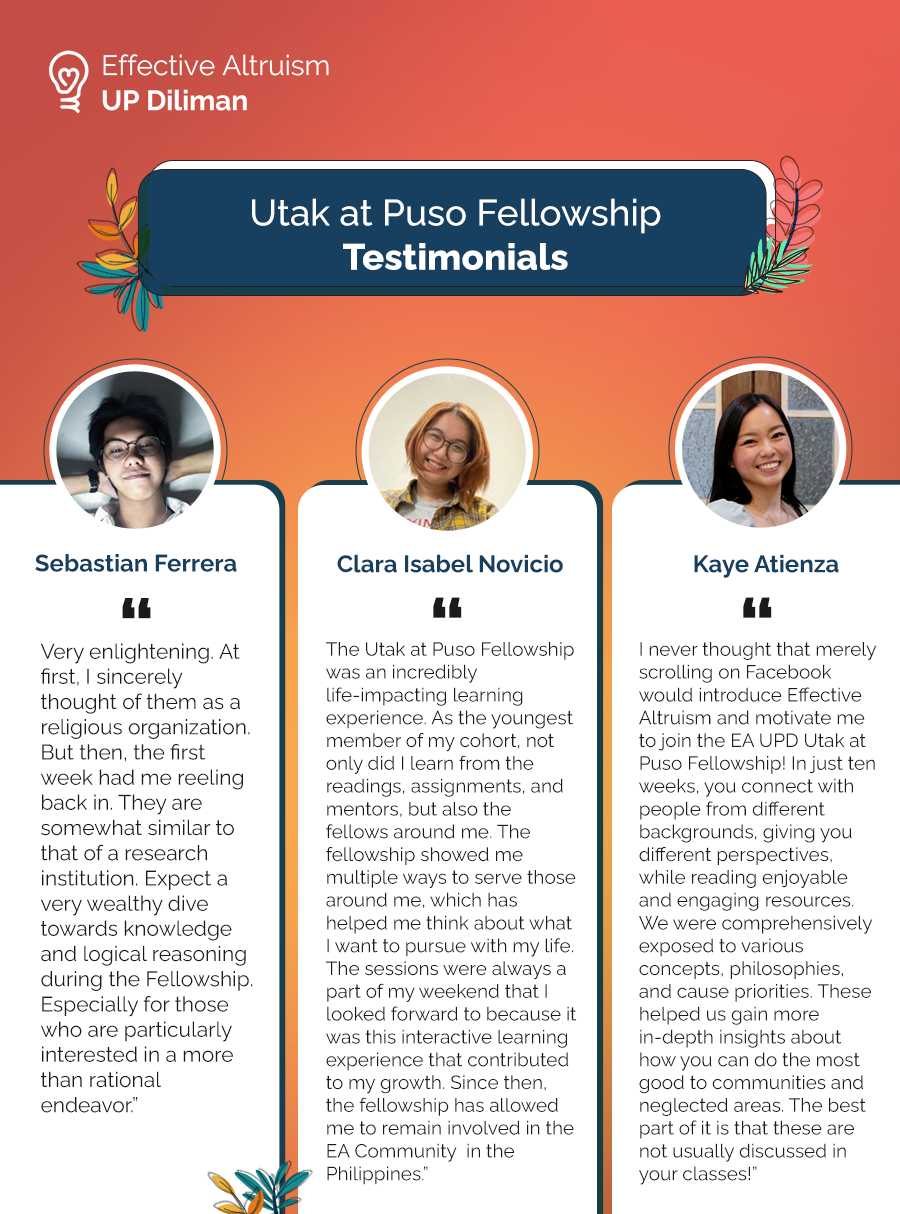
Appendix
Appendix A: Intro Talk program
Our program went this way:
- Icebreaker (15 min)
- To have participants introduce themselves and talk about initial interest in EA
- We had six breakout rooms with 1-2 facilitators from EA UPD and EA Philippines.
- Talk Proper (30 min)
- Question & Answer (10 min)
- Breakout Rooms (15 min)
- To know what they think about the talk
- We kept the groupings from the icebreaker because aside from being easier logistically, it could lead to better conversations since the participants could be more comfortable with the group already and information from the icebreaker could help them better understand each other.
Appendix B: Our Discord server
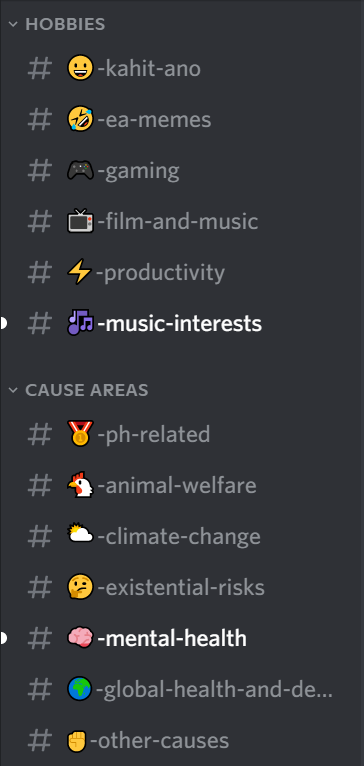
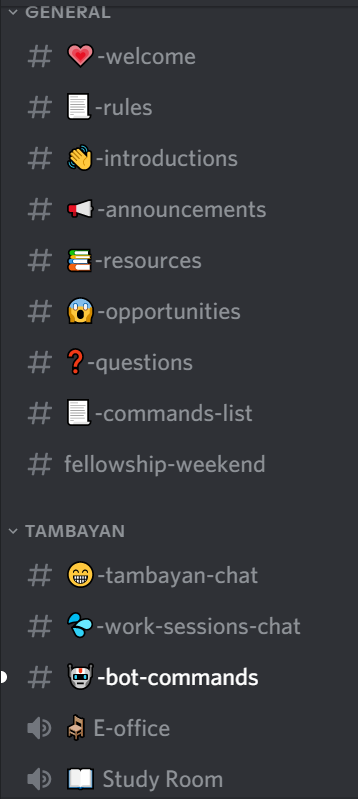
Appendix C: Our fellowship resources
- Syllabus
- Facilitator Guide
- Copy of our Mastersheet
- Project Overview
- Process - contains tasks per phase, tasks every meetup and the fellowship schedule
- Program Flow - for the meetups
- Attendance Tracker
- Socials Event planning
- Interview Template
- Evaluation Summary
- Completion Survey

Thank you Shen, this is wonderful! With my local group in Colombia we're getting ready to stage a fellowship for the second time and hearing about your experience gave me many ideas for things we may try to improve on.
This is good to hear! We will be running our second intro fellowship soon too and I'm wishing you the best of luck for yours.
This is so cool, thanks so much!